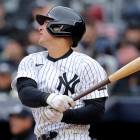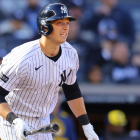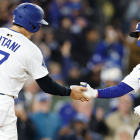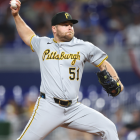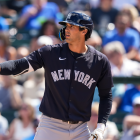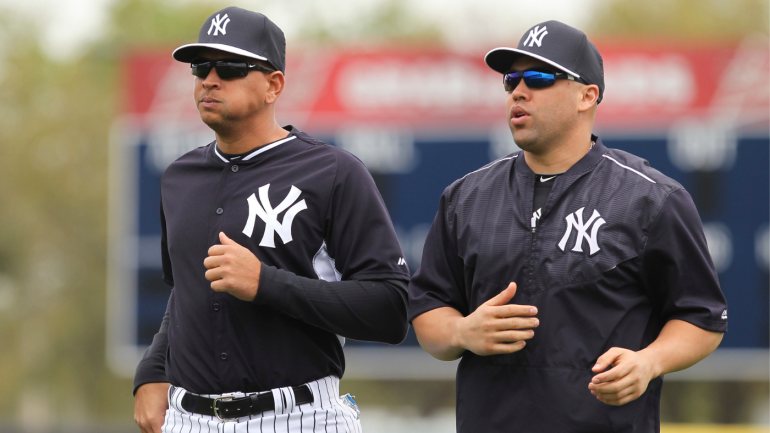
The 2023 Baseball Hall of Fame ballot was revealed on Monday. This is the BBWAA ballot, meaning it features players who have been retired at least five years and those who are holdovers from previous ballots for having received between five and 75 percent of the vote. Here's the full 28-player ballot.
Players who receive less than five percent of the vote fall off the ballot and those with at least 75 percent will be enshrined in Cooperstown as Hall of Famers next year. Everyone else will have 10 chances on the ballot to make it in before lapsing. The 2023 Baseball Hall of Fame class will be announced in January.
Let's run through the biggest storylines on the ballot this year.
1. The Era Committee ballot is separate
First things first: The ballot that has Barry Bonds, Roger Clemens, Curt Schilling and more isn't this one. The ballot revealed Monday was the BBWAA ballot -- something Bonds, Clemens and Schilling are no longer eligible for.
The Contemporary Baseball Era Players ballot has Bonds, Clemens, Schilling, Rafael Palmerio, Albert Belle, Dale Murphy, Don Mattingly, and Fred McGriff. There is a 16-person committee that will hold a vote during the winter meetings on Dec. 4 and if any of the players get 12 votes, they'll get into the Hall of Fame in the 2023 class.
This has absolutely nothing to do with the BBWAA vote; they are two totally different things.
Onto the BBWAA ballot!
2. The Beltrán question
We will be delving into many individual candidacies more at a later date, but just on the surface, Carlos Beltrán looks like the only Hall of Famer from this group of ballot rookies. The other first timers of note: John Lackey, Jered Weaver, Francisco Rodríguez, Matt Cain, Jacoby Ellsbury, Jayson Werth, J.J. Hardy, Mike Napoli, Andre Ethier and, well, you get the point. It's Beltrán or bust for this class (though I suppose K-Rod could hang around on the ballot for a bit).
He has the numbers. Beltrán in parts of 20 seasons was a nine-time All-Star and had the "it" factor as a five-tool superstar. He hit .279/.350/.486 (119 OPS+) with 2,725 hits, 1,582 runs, 1,587 RBI, 565 doubles, 435 homers and 312 stolen bases. In 65 career playoff games, he hit .307/.412/.609 with 15 doubles, 16 home runs, 42 RBI and 45 runs. Among center fielders, he ranks eighth in WAR (not far off Joe DiMaggio and ahead of Duke Snider, Andre Dawson and Richie Ashburn).
It would've been a lot less complicated to argue his numbers -- and I have no doubt that some people will push back against those as worthy numbers, as misguided as that argument would be -- but then we have the Astros sign-stealing scandal.
I have absolutely no idea how this will affect matters. Connections to PEDs have kept a number of otherwise-worthy candidates out. This isn't that, but Beltrán was said to be one of the ringleaders of the sign-stealing operation in Houston in 2017 (his final year as an MLB player). He didn't really pad his stats that season -- it was the worst offensive season he had post-2000 -- but his involvement could cause him to lose votes via the so-called character clause.
This isn't just about Beltrán. We might end up having to discuss this down the road with some players from that Astros team, most notably Jose Altuve, who has a great foundation for a Hall of Fame resume right now.
For me, this is easily the most impactful storyline on the 2023 ballot. We'll find out in the coming weeks what the voting body collectively thinks about the matter.
3. Can A-Rod make big gains?
Something we've known for years about the BBWAA voting body is that a decent enough portion are PED hardliners to have kept the likes of Bonds, Clemens, Palmeiro, Mark McGwire, Sammy Sosa, etc. out.
Bonds and Clemens did make a surge up to around 2/3 of the vote, though, and the voting body will continue to skew more and more "new school" as the years go on. New, younger voters gain votes while older voters lapse or pass away. As we get further away from the "Steroid Era," do Alex Rodriguez's chances get better?
The reason I mentioned Bonds and Clemens is that they were special cases. We've seen some voters make distinctions on the PED-connected players to say that some reached their Hall-level numbers due to the extra help but that Bonds and Clemens were already Hall of Fame type players before allegedly using anything. I think we can all agree A-Rod is more on level with Bonds and Clemens in terms of his natural ability. There's an argument to be made that he was the most physically gifted player of all-time (at least until the two-way exploits of Shohei Ohtani).
His PED suspension, obviously, clouds matters for someone who otherwise would have gotten close to 100 percent of the vote.
A-Rod got 34.3 percent of the vote last year in his first go-round. Bonds got 36.2 percent his first year and ended with 66 percent. Bonds didn't make significant gains until his fourth and fifth years, though, so if A-Rod sees a big jump this year, it's possible he has a chance.
If he gets close to 50 percent, I'd venture a guess that he'll eventually get in. If he sits around 1/3, I'd guess he never will via the BBWAA route.
4. It could be Rolen's year
Perhaps the best bet to get in on this ballot is Scott Rolen. He only got 10.2 percent of the vote his first year, but as the ballot continues to clear out big names and the new-school crowd continues to make his case as an underrated all-around player (WAR loves him), he's gained serious momentum. Rolen rose to 63.2 percent last year and it seems like a matter of "when" and not "if."
5. Helton, Jones trying to continue momentum
As a reminder, we'll get into individual cases in the coming weeks. This is a scene setter and I'm not here to argue one way or the other on each candidate right now (though, admittedly, I did a little bit above with Beltrán to help fully illustrate why his candidacy is so interesting).
Todd Helton is trending very strong. This is the fifth year he's on the ballot and so far he's gone 16.5 percent, to 29.2, to 44.9 and then 52 percent. There's an outside chance he gets in this year, though a 23 percent bump would be a huge. Fellow Rockies legend Larry Walker jumped 22 percent in one year to get in, but it was his final year. Helton won't inspire that sort of urgency in Year 5.
Andruw Jones' case looked like a lost cause through two years. He hung around on the ballot with 7.3 percent and then 7.5. Then he jumped to 19.4, 33.9 and last year hit 41.4 percent. It's been five tries and he has up to five more. If things keep moving in that direction, he'll eventually make it via the BBWAA vote as a Hall of Famer, though nearly 34 percent is still a steep climb. Sometimes the momentum builds until a player makes it and other times the support plateaus short of the 75 percent threshold as we run into a swath of voters who won't change their minds.
My hunch is Jones needs to crack 50 percent this year. As for Helton, he's on track to get in, though it won't be this year.
6. Kent's last ride
Five-time All-Star and 2000 NL MVP Jeff Kent is on the ballot for the 10th and final time. With 560 doubles, 377 home runs, 1,518 RBI and nearly 2,500 hits, he's one of the most prolific offensive second basemen of all-time. Defense held him back a bit, and for that reason and perhaps some others, he's been unable to build a serious ballot run like Rolen, Helton and Jones. He has gained, to be clear, jumping from 18.1 percent of the vote in his sixth try to 32.7 in his ninth try, but in the latter case the percentage had essentially stagnated (he was 32.4 percent in his eighth try).
There's no even remotely recent precedent for someone gaining over 40 percent to get inducted into the Hall of Fame in one voting cycle. The largest two-year gain since 1966 was 42.7 percent by Luis Aparicio from 1982-84, according to Jay Jaffe at Fangraphs). That gain on a percentage basis for Kent would get him in by 0.4 percent, but he needs it to happen in one year, not two. And, again, that's the record.
Basically, this is the last time for Jeff Kent on the ballot before heading to the Era Committee (and, frankly, he'll probably fare better there).
7. The end is near for Wagner, Sheffield
We'll loop these two together because they are in similar territory. Billy Wagner was one of the most formidable closers in baseball history, even in a relatively diminutive frame, thanks to a blazing fastball. Gary Sheffield was one of the most fearsome hitters of his generation and the menacing bat waggle is timeless.
Again, we'll make time later for extended discussions on the cases, but Wagner is sixth in career saves with excellent rate stats while Sheffield had over 500 homers, over 1,600 RBI and runs and a 140 OPS+.
Sheffield is in his ninth year on the ballot and while he made a huge leap from 2019 to 2020, he got exactly 40.6 percent in each of the last two voting cycles. He'll need a huge leap this year to have a chance next.
Wagner is in his eighth try and might have a better shot. His path the last five votes, by percentage: 11.1, 16.7, 31.7, 46.4 and 51. If he moves up over 60 percent this time, there's a real chance he'll make it, but there also might be enough voters out there who need a closer to be Mariano Rivera in order to get a Hall vote. It's possible Wagner will plateau.
8. Rollins, Abreu, Buehrle, Hunter look for jump
As noted above, Jones sat below 10 percent his first two years before starting to make serious headway. The following players are hoping to see a big leap into Hall of Fame ballot relevance this year:
- Jimmy Rollins: 9.4 percent last year in his ballot debut
- Bobby Abreu: 8.6 percent last year in his third try
- Mark Buehrle: 5.8 percent last year in his second try
- Torii Hunter: 5.3 percent last year in his second year
There's also the chance one or more of these guys get less than five percent and fall off the ballot, though with only Beltrán a threat among first-timers, it doesn't seem likely.
9. No-man's land for Manny, Vizquel, Pettitte
The three remaining holdovers on the ballot seem to have too much baggage for induction.
Andy Pettitte's case is probably mostly a lost cause because his numbers are more a "Hall of the Very Good" type for many, and he was also connected to PEDs. He's on his fifth ballot and has gotten 13.7 percent of the vote before, but it fell to 10.7 percent last voting cycle.
Manny Ramírez's offensive numbers are overwhelming enough that he'd already be in the Hall if not for the PED connection. And in his case, it's much more than just whispers or the Mitchell Report or anything speculative. He was suspended twice under the Joint Drug Agreement for performance-enhancing drug violations. This has been a non-starter for his candidacy for a large majority of the voting body, topping out at 28.9 percent last season. He was at 28.2 percent in each of the previous two votes, so he's not really moved. He's just not cracking 30 percent, it appears. This is the seventh year for him on the ballot.
Omar Vizquel topped 50 percent in his third ballot and was likely getting close to Cooperstown, but then allegations of domestic violence surfaced. The following summer, he faced ugly allegations that he had subjected a bat boy, who has autism, to "sexual harassment and disability discrimination." His vote percentage cratered to 23.9 percent last year, very likely as a direct result. This is Vizquel's sixth time on the ballot and it's likely just a formality until he falls off the ballot at this point.
Andruw Jones was also arrested on domestic assault charges in 2012.
10. Prediction
I think the Era Committee puts in McGriff. I'm confident Rolen will make it a two-man class. I have no idea in the world how the sign-stealing thing affects Beltrán, but I'll say it's enough to keep him below 75 percent, at least in this his first try.
![[object Object] Logo](https://sportshub.cbsistatic.com/i/2020/04/22/e9ceb731-8b3f-4c60-98fe-090ab66a2997/screen-shot-2020-04-22-at-11-04-56-am.png)









